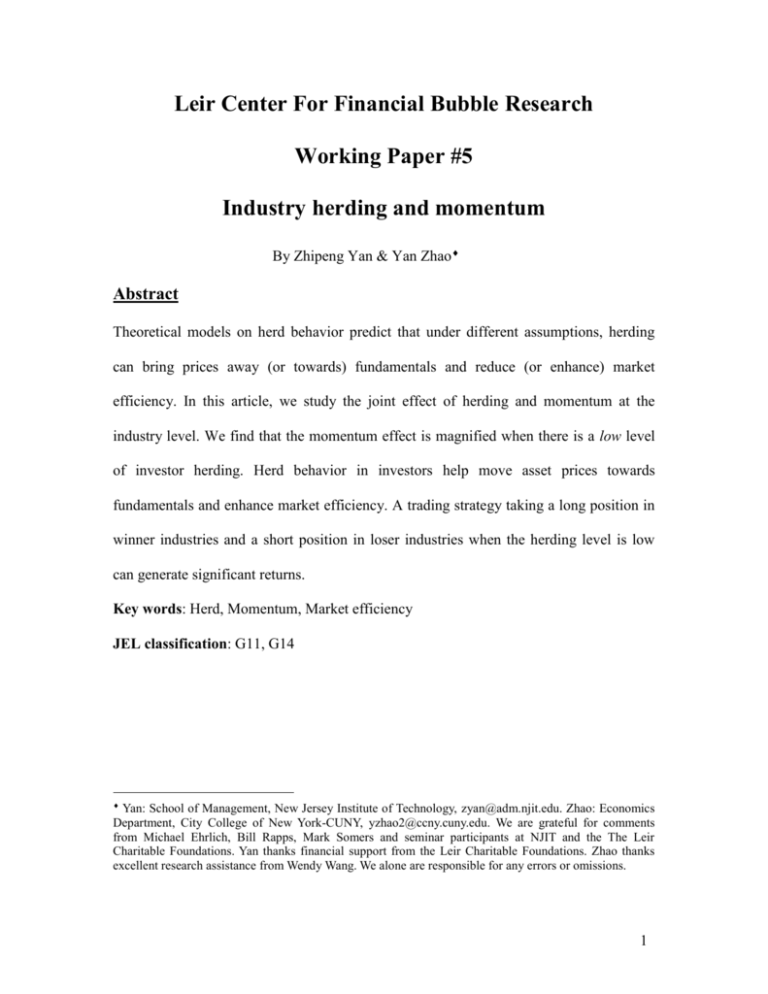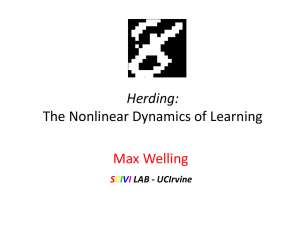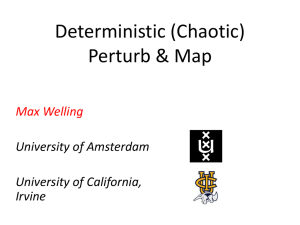Industry herding and reversals in equity markets
advertisement

Leir Center For Financial Bubble Research Working Paper #5 Industry herding and momentum By Zhipeng Yan & Yan Zhao Abstract Theoretical models on herd behavior predict that under different assumptions, herding can bring prices away (or towards) fundamentals and reduce (or enhance) market efficiency. In this article, we study the joint effect of herding and momentum at the industry level. We find that the momentum effect is magnified when there is a low level of investor herding. Herd behavior in investors help move asset prices towards fundamentals and enhance market efficiency. A trading strategy taking a long position in winner industries and a short position in loser industries when the herding level is low can generate significant returns. Key words: Herd, Momentum, Market efficiency JEL classification: G11, G14 Yan: School of Management, New Jersey Institute of Technology, zyan@adm.njit.edu. Zhao: Economics Department, City College of New York-CUNY, yzhao2@ccny.cuny.edu. We are grateful for comments from Michael Ehrlich, Bill Rapps, Mark Somers and seminar participants at NJIT and the The Leir Charitable Foundations. Yan thanks financial support from the Leir Charitable Foundations. Zhao thanks excellent research assistance from Wendy Wang. We alone are responsible for any errors or omissions. 1 Industry herding and momentum 1. Introduction Herd behavior, or the tendency of individuals in a group to ‘follow the trend,’ has frequently been observed in equity markets. Herd behavior in investors leads to a convergence of action (Hirshleifer and Teoh, 2003). There are at least two important strands of literature on herd behavior. The first is that mutual imitation among investors may temporarily drive asset prices away from fundamental values, and move the market towards inefficiency in an information cascade (Banerjee, 1992; Bikhchandani et al., 1992; Bikhchandani and Sharma, 2001). The second strand shows that uninformed traders can become informed by imitating the observed movement in the market. In that way, herd behavior in investors may help impound information about fundamentals into asset prices, and enhance market efficiency (Froot et al., 1992; Hirshleifer et al., 1994; Hey and Morone, 2004). A large body of empirical studies investigates herd behavior in equity markets. However, the empirical studies thus far do not focus on testing any particular herd model proposed in the theoretical literature. They either focus on the herd behavior of professional investors or on market-wide herding. In the first case, professional investors, such as institutional money managers and financial analysts, are evaluated versus the performance of their peers or benchmark index returns. Thus they tend to buy or sell assets following each other. For instance, Grinblatt et al. (1995) provide evidence that mutual funds tend to buy and sell the same stocks at the same time (i.e., herd) in excess of what one would expect from pure chance. Voronkova and Bohl (2005) show that pension funds in the Polish stock market are 2 involved in herd behavior to a great extent. Dass, Massa, and Patgiri (2008) find empirical evidence that mutual funds herd around the technology bubble. In the second case, the empirical studies aim to establish the presence of herd behavior in the stock market. Chang, Cheng and Khorana (2000) show significant evidence of herding in South Korea and Taiwan. Hwang and Salmon (2004) use the cross-sectional (market-wide) standard deviation of individual security returns to measure herd behavior. They find that herd behavior in the market is significant and independent from market conditions in the US and South Korean stock markets. Caparelli et al. (2004) also find herd behavior in Italian stock markets. Caporale, Economou, and Philippas (2008) test and establish the presence of herding in extreme market conditions based on data from the Athens stock exchanges. Tan et al. (2008) examine herd behavior in Chinese stock markets, and provide evidence of herding within both the A-share and B-share markets. Most of the existing empirical studies focus on the herding of individual stock or market index returns. Few study herd behavior at the industry level. Using Fama-French 49 industry classification, Choi and Sias (2008) find institutional investors follow each other into and out of the same industries. Jame and Tong (2009) document that retail investors herd on the industry level on both weekly and monthly investment horizons. In this paper, we focus on the industry level. Different from Choi and Sias (2008) and Jame and Tong (2009), we don’t utilize investor holdings change as a measure of herding. Instead, we use stock return dispersions (cross-sectional standard deviation and absolute deviation) at the industry level as measures of industry-level herding. This paper aims to fill the gap of isolated theoretical and empirical studies, and to address the following question: Whether herd behavior creates price bubbles or enhances 3 market efficiency at the industry level? To answer this question, we study the joint effect of herd behavior and momentum. By linking herding and momentum at the industry level, we contribute to the two strands of literature. Stock market price momentum was first documented by Jagadeesh and Titman (1993, 2001). Stocks that have previously exhibited positive returns (winners) continue to outperform stocks that have previously exhibited negative returns (losers). Chan, Jegadeesh, and Lakonishok (1996) suggest that this predictability of future returns is due to the market’s underreaction to information. They show that the stock market responds only gradually to new information. If momentum is the result of a gradual movement of the stock market towards efficiency and if herd behavior temporarily drives asset prices away from fundamental values, then we can expect investor herd behavior to slow down the rate of movement towards efficiency. Stocks with a high level of herding will then exhibit a larger momentum effect than will stocks with a low level of herding. If, on the other hand, herding can help impound fundamental news into asset prices, and enhance market efficiency, investor herding will accelerate the rate of movement to efficiency so stocks with a low level of herding will exhibit the momentum effect more than stocks with a high level of herding. The existing theories of herding make no definite priori predictions about the impact of investor herding activity on the momentum effect at the industry level, thus our approach is strictly empirical. We found that the stock price momentum is significantly enhanced by a low level of herding. Winner industries with a low level of herding generate higher subsequent returns than those with a high level of herding. Loser 4 industries with a low level of herding generate lower subsequent returns than those with a high level of herding. We conclude that the herd effect plays an important role in the momentum effect and has predictive power in future price movement. Our empirical findings are consistent with the second strand of herd behavior literature. Acting in a herd, investors help move asset prices towards fundamentals and enhance market efficiency. This paper contributes to current literature by linking herd behavior and momentum at the industry level, and by providing evidence that herd behavior enhances market efficiency. The remainder of this paper is organized as follows. Section 2 discusses the data and methodology. Section 3 presents empirical evidence, which is followed by robustness checks. Section 5 concludes. 2. Data and Methodology We obtain data on individual stock returns, and industry classifications (SIC codes) from the Center for Research and Security Prices (CRSP). All ordinary shares (CRSP share code 10 or 11) from January 1980 to December 2008 are included. We assign each stock to one of 49 or 30 Fama and French industries. The updated industry definitions are available on Ken French’s website. Following Christie and Huang (1995), we estimate the cross-sectional standard deviation (CSSD) of single stock returns with respect to industry mean returns, which is expressed as: N (R i,t CSSDt = Rm,t )2 i=1 N 1 ……………………………………………………………(1). 5 Here, Ri , t is the observed stock return of firm i at time t, R m, t is the cross-sectional average return of N stocks in the industry at time t, and N is the number of stocks in the industry. Although the cross-sectional standard deviation of returns is an intuitive measure to capture herd behavior, it can be considerably affected by the existence of outliers. That is why Christie and Huang (1995) and Chang, Cheng and Khorana (2000) proposed the use of the cross-sectional absolute deviation (CSAD) as a better measure of dispersion: N R i,t CSADt = Rm,t i=1 N As a dispersion measure, either CSSD or CSAD indicates a high level of herding when its value is low. In other words, when stocks in the same industry move in tandem, or herd, the dispersion is small. We begin by assigning each stock to one of the 49 Fama and French industry portfolios according to their historical industry classification. We assign each stock to an industry portfolio at the end of June of year t based on its four-digit SIC code at that time. We use not only CRSP, but also Compustat as a source of SIC codes. We use Compustat SIC codes (for the fiscal year ending in calendar year t-1) whenever available. Otherwise, we use CRSP SIC codes (for June of year t). Each stock return is equally weighted to generate industry returns. Results are very similar if we value weight each stock return. In each month, we calculate the past 6-month returns in each industry as a proxy for winners and losers. The past 6-month returns are the 7- to 1-month returns. We intentionally exclude the most recent one month return to attenuate problems associated with microstructure issues such as the effect of bid-ask bounce (see Asness, 1995). The 6 herding level is calculated using the previous 1-month returns. Different window lengths of herding and momentum measures are also considered. To ensure our herding measure is not influenced by a few deviant observations, we require that each industry have at least 10 stocks. The tobacco industry is not included in our analysis, which, on average, has only 6 stocks. Table 1 reports the summary statistics. On average, the largest industry in terms of market capitalization is the beer and liquor industry, which accounts for roughly 13% of the total stock market capitalization for the 49 industry classifications. The banking industry has the largest number of firms among all industries. Monthly average returns range from a low of 0.11% for Coal to a high of 1.74% for Candy & Soda. The computer software industry is characterized by the highest volatility with the CSSD of 19.85% and CSAD of 13.60%; the utilities industry enjoys the lowest volatility with the CSSD of 6.47% and CSAD of 4.32%. It is not very surprising due to the fact that the utilities industry is heavily regulated. For instance, many utility companies during our sample period confronted rate of return on capital or price cap regulation. With similar regulatory constraints, utilities firms should have relatively similar performance and therefore, have highly correlated stock returns. 3. Empirical results Table 2 reports the empirical results using monthly data. At the end of each month, we calculate the previous 6-month (t-7 to t-1) returns for each industry and group the top 50% as winner industries and the lower 50% as loser industries. Independently, we calculate the CSSD and CSAD for each industry using the previous 1-month returns. Based on CSSD or CSAD, the bottom 30% are labeled as high level of herding; the top 7 30% as low level of herding; and the middle 40% as medium level of herding. In this way, all industries are organized into 6 portfolios. We first look at the loser industries. The subsequent 1-month, 2-month and 3-month cumulative returns of loser industries with a low level of herding (CSSD) are 0.78%, 1.28% and 2.09%, respectively. These returns are significantly smaller than those of loser industries with a high level of herding, whose returns are 0.86%, 1.63%, and 2.53%, respectively. This reflects that a low level of herding enhances the momentum effect – loser industries with a low level of herding perform worse than loser industries with a high level of herding. We then look at the winner industries. The story is similar here. Winner industries with a low level of herding (CSSD) have higher subsequent cumulative returns than winner industries with a high level of herding. The subsequent 1-month, 2-month and 3month cumulative returns of winner industries with a low level of herding (CSSD) are 1.66%, 3.11% and 4.71%, respectively. These returns are significantly higher than those of winner industries with a high level of herding, whose returns are 1.21%, 2.43%, and 3.82%, respectively. The patterns are the same when we use CSAD as the measure of herding. The empirical results show that winner industries with a low level of herding generate higher subsequent returns than those with a high level of herding. Loser industries with a low level of herding generate lower subsequent returns than those with a high level of herding. The fact that the momentum effect is more significant when the herding level is low is consistent with the notion that herd behavior helps incorporate news of fundamentals into asset prices. Thus the future returns of industries with a high level of 8 herding are less extreme compared with those of industries with a low level of herding. This lends support to the second strand of herding theories - herding will accelerate the rate of movement to market efficiency. Based on these findings, we can easily design a long-short portfolio. A trading strategy taking a long position in winner industries and a short position in loser industries when herding level is low can generate significant returns. Under the 49 industry classification, the spread of 1-month, 2-month and 3-month cumulative returns are 0.88%, 1.85%, and 2.62% using CSSD as the proxy for herd behavior, and 1.19%, 2.18%, and 3.10% using CSAD as the proxy for herd behavior. All the spreads are statistically significant. Figure 1 shows the annually cumulative long-short portfolio returns during our sample periods. The strategies incur losses in 3 out of 29 years. Maximum gain is in 1999, and maximum loss in 2002. Average Sharpe ratios are 1.15. This is not entirely surprising, considering our strategy is an enhanced momentum strategy. Most momentum strategies did quite well in the late 1990s when the internet bubble was at its peak. Since some industries, such as computer Software, have relatively low levels of herding, investors may consistently go long some industries and short other industries. Then this herding-momentum strategy is just an industry bet in disguise. If by pure chance, the possibility of an industry being in either long or short portfolio is 15 percent, which equals the product of 50 percent of being either a loser or winner industry and 30 percent of being a low herding industry. Table 3 lists the occurrence percentage of an industry appearing in either long or short portfolio during our sample period and it seems that the portfolio choice is not random. The utilities industry, which 9 consistently has a very high level of herding, is not selected even once during the sample period. Some industries, such as Computers, Pharmaceutical Products and Computer Software, are selected much more often than other industries, such as Defense, Candy & Soda, and Coal. To alleviate the selection bias (towards industries with low levels of herding), we normalize the herding measures for each industry. z CSSD j ,t CSSD j ,t CSSD j CSSD j Here, CSSD j ,t is the original CSSD for industry j in month t; CSSD j is the mean value of CSSDs of industry j over our sample period; CSSD j is the standard deviation of CSSDs of industry j; z CSSD j ,t is the normalized value or z-score of CSSD for industry j in month t. Similarly, we compute z CSAD j ,t for each industry in each month. In Panel A of Table 4, we provide the occurrence percentages for industries when zscores of CSSD or CSAD are used in the portfolio construction. The industry selection bias is greatly reduced with normalization. Most occurrence percentages are around 15 percent and much more evenly distributed than those in Table 3. Panel B reports portfolio performance. The patterns are very similar to those in Table 3. Winner (loser) industries with a low level of herding generate higher (lower) subsequent returns than those with a high level of herding. The long-short portfolios also generate positive and significant returns, but the degree of significance is slightly smaller than that in Table 3 when original CSSD and CSAD data are employed. To be more conservative and alleviate industry selection bias, we will use z-scores only in our empirical tests hereinafter. 10 According to Christie and Huang (1995), herding is more likely during stress periods in the market when investors tend to suppress their own beliefs and follow the market consensus. Demirer and Kutan (2006) show that return dispersions during extreme downside movements of the market are much lower than those for upside movements. Stock returns behave more similarly during down markets. Thus, we further investigate whether or not the above patterns hold during economic recession periods. We investigate the two most recent crisis periods. The first one is the dot com crisis period from 2001-2002; the second one is the financial crisis from 2007-2008. The results are presented in Table 5. Although all subsequent returns reported are negative, our previous findings still hold during the recessions. For example, the 3-month cumulative returns of loser industries with a low level of herding (CSSD) is -4.32%, which is lower than those of loser industries with a high level of herding (-3.40%). The high-herding winner industries have a 3-month cumulative return of -2.62% that is lower than that of the winner industries with low-herding (-1.18%). The spread of the trading strategy taking a long position in low-herding winner industries and a short position in lowherding loser industries can generate 1.12%, 2.5%, and 3.15% spread over the following 1-month, 2-month and 3-month periods. All the spreads are statistically significant. To summarize, we sort Fama-French 49 industries by the industry-level momentum and herding. We find that high-level herding reduces the momentum effect whether we use original herding measures or normalized herding measures, and whether it is during a crisis period or not. Our findings support the second strand of theories on herding (Froot et al., 1992; Hirshleifer et al., 1994; Hey and Morone, 2004) that herding may enhance market efficiency, at least, at the industry level. 11 4. Robustness Checks So far, we only used Fama-French 49 industry classifications in our tests. Our first robustness check is to employ different industry classifications. Table 6 reports the results for the Fama-French 30 industry classification. Our main results remain the same. For loser industries with low level of herding (CSSD), the subsequent 1-month, 2-month and 3-month cumulative returns are 0.61%, 1.19% and 1.80%, respectively, lower than those of loser industries with a high level of herding (0.89%, 1.81% and 2.62%, respectively ). For winner industries with a low level of herding, future 1-month, 2month and 3-month cumulative returns (1.68%, 3.18% and 4.72%, respectively) are higher than those of winner industries with a high level of herding (1.10%, 2.27% and 3.65%). The long-short trading strategy conditional on low-level of herding also generates significant returns. In an unreported table, we define industries according to SIC 3-digit codes and the results are unchanged. Previously we calculated the past 6-month returns in each industry as a proxy for winners and losers, and the herding level is calculated using the previous 1-month returns. Now, different window lengths are used to measure herding and momentum. Results are presented in table 7. In Panel A, we use the past 12-month (t-13 to t-1) returns as the proxy for the momentum. The patterns are similar. Our trading strategies generate spreads of 0.64%, 1.18%, and 1.86% over 1-month, 2-month and 3-month periods when CSSD is employed as the proxy for herding; and 0.69%, 1.16%, and 1.71% when CSAD is the proxy for herding. All spreads are statistically significant. Panel B reports results for herd behavior that is calculated using the previous 6-month returns, and momentum 12 past 6-month returns. Again the patterns are similar; all our trading strategies yield significant returns. Finally, we examine the above pattern using weekly data, instead of monthly data. At the end of each week, we calculate the previous 6-week returns for each industry and group the top 50% as winners and bottom 50% as losers. Independently, we calculate the CSSD and CSAD using the previous 1 week returns. The bottom 30% based on CSSD or CSAD are labeled as high level of herding, and the top 30% as low level of herding. Table 6 reports the empirical results using weekly data. All main results hold at the weekly level. 5. Conclusion This paper fills the gap uncovered in theoretical and empirical studies on herd behavior, and examines if herd behavior creates price bubbles or enhances market efficiency at the industry level. We study the joint effect of herd behavior and momentum. Our empirical findings show strong evidence that the momentum effect is magnified when there is a low level of investor herding. Thus, by acting in a herd, investors help move asset prices towards fundamentals and enhance market efficiency. Winner industries with a low level of herding generate higher subsequent returns than winner industries with a high level of herding. Loser industries with a low level of herding generate lower subsequent returns than loser industries with a high level of herding. A trading strategy taking a long position in winner industries and a short position in loser industries when herding level is low can generate significant returns. 13 References: Asness, C.S. (1995) The power of past stock returns to explain future stock returns. Unpublished working paper, Goldman Sachs Asset management. Banerjee, A. (1992) A Simple Model of Herd Behavior. The Quarterly Journal of Economics, 107, 3, 797-817. Bikhchandani, S., Hirshleifer, D., and Welch, I. (1992) A Theory of Fads, Fashion, Custom, and Cultural Change as Informational Cascades. Journal of Political Economy, 100, 5, 992– 1026. Caparrelli, F., Arcangelis, A.M., and Cassuto, A. (2004) Herding in the Italian Stock Market: A Case of Behavioral Finance. Journal of Behavioral Finance, 5, 4, 222-230. Caporale, G, M., Economou, F., and Philippas, N. (2008) Herding behavior in extreme market conditions: the case of the Athens stock exchange, Economics Bulletin, 7, 17, 1-13. Chan, L., Jegadeesh, N., and Lakonishok, J. (1996) Momentum Strategies, Journal of Finance, 51, 1681–1713. Chang, E. C., Cheng, J. W., and Khorana, A. (2000) An examination of herd behavior in equity markets: an international perspective, Journal of Banking and Finance, 24, 1651– 1679. Christie, W. G., and Huang, R. D. (1995) Following the pied piper: do individual returns herd around the market? Financial Analysts Journal, 51, 4, 31–37. Choi, N., and Sias, R. (2008) Institutional industry herding, Journal of Financial Economics forthcoming Dass, N., Massa, M., and Patgiri, R., (2008) Mutual funds and bubbles: the surprising role of contractual incentives, Review of Financial Studies, 21, 51-99. Demirer, R. and Kutan, A., (2006) Does Herding Behavior Exist in Chinese Stock Markets? Journal of International Financial Markets, Institutions and Money, 16, 2, 123-142. Froot, K., Scharfestein, D., and Stein, J. (1992) Herd on the Street: Informational Inefficiencies in a Market with Short-Term Speculation,” Journal of Finance, 47, 1461-1484. Grinblatt, M., Titman, S., and Wermers, R., (1995) Momentum Investment Strategies, Portfolio Performance, and Herding: A Study of Mutual Fund Behaviour. The American Economic Review, 85, 5, 1088-1105. Hey, J., and Morone, A. (2004) Do Markets Drive out Lemmings - or vice versa? Economica, 71, 284, 637-659. 14 Hirshleifer, D. ( 2001) Investor Psychology and Asset Pricing, Journal of Finance, 56, 4, 1533-1598. Hirshleifer, D., Subrahmanyam, A., and Titman, S. (1994) Security Analysis and Trading Patterns When Some Investors Receive Information Before Others. Journal of Finance, 49, 1665-1698. Hirshleifer, D., and Teoh, S. H. (2003) Herd behavior and cascading in capital markets: a review and synthesis, European Financial Management, 9, 25–66. Hwang, S., and Salmon, M. (2004) Market stress and herding, Journal of Empirical Finance, 11, 585-616 Jame, R., and Tong, Q. (2009) Retail investor industry herding, working paper, Emory University Jegadeesh, N., and Titman, S. (1993) Returns to buying winners and selling losers: Implications for stock market efficiency, Journal of Finance, 48, 65-91. Jegadeesh, N., and Titman, S. (2001) Profitability of momentum strategies: An evaluation of alternative explanations, Journal of Finance, 56, 699-720 Tan, L., Chiang, T. C., Mason, J. R., and Nelling, E. (2008) Herding behavior in Chinese stock markets: An examination of A and B shares, Pacific-Basin Finance Journal, 16, 61–77. Voronkova, S., and Bohl, M.T. (2005) Institutional Traders’ Behavior in an Emerging Stock Market: Empirical Evidence on Polish Pension Fund Investors, Journal of Business, Finance and Accounting, 32, 1537-1560. 15 Table 1. Summary Statistics Each month, from January 1980 to December 2008, we classify stocks into one of Fama and French 49 industries. # of Firms reports the time series average the number of firms in each industry. ME is the time series average industry market equity value as a percentage of the whole market. Return is the mean monthly returns. CSSD1 and CSAD1 are the cross-sectional standard deviation of returns and cross-sectional absolute deviation of returns using previous 1 month data. 49 Industries Aircraft Agriculture Automobiles and Trucks Banking Beer & Liquor Construction Materials Printing and Publishing Shipping Containers Business Services Chemicals Electronic Equipment Apparel Coal Construction Pharmaceutical Products Electrical Equipment Fabricated Products Trading Food Products Entertainment Precious Metals Defense Computers Healthcare Consumer Goods Insurance Measuring and Control Equipment Machinery Restaraunts, Hotels, Motels Medical Equipment Non-Metallic & Industrial Metal Mining Petroleum and Natural Gas Almost Nothing Business Supplies Personal Services Retail Real Estate Rubber and Plastic Products Shipbuilding, Railroad Equipment Candy & Soda Computer Software Steel Works Etc Communication Recreation Transportation Textiles Utilities Wholesale # of Firms 23 14 62 417 14 107 43 18 240 80 259 67 11 58 200 76 25 168 77 69 21 11 137 82 88 141 111 167 90 142 16 192 36 63 53 233 42 48 12 13 267 65 103 41 100 35 145 187 ME 5.67% 0.72% 2.18% 1.84% 12.89% 1.15% 2.29% 1.39% 0.75% 2.60% 1.67% 0.82% 2.90% 0.77% 3.38% 1.78% 0.18% 2.04% 3.06% 1.70% 0.65% 1.58% 3.56% 0.63% 3.07% 3.56% 0.71% 1.13% 1.07% 0.99% 1.47% 3.79% 1.53% 2.56% 0.70% 2.57% 0.38% 0.50% 2.60% 1.79% 1.65% 1.32% 5.82% 0.50% 1.75% 0.53% 3.09% 0.73% Return 1.53% 1.04% 0.83% 1.35% 1.16% 1.10% 0.82% 1.28% 1.31% 1.04% 1.48% 1.01% 0.11% 0.90% 1.74% 1.08% 0.88% 1.57% 1.18% 0.91% 0.75% 1.54% 1.15% 1.46% 0.96% 1.36% 1.39% 1.16% 0.69% 1.33% 0.73% 0.96% 1.02% 0.88% 1.01% 1.06% 0.77% 1.14% 0.11% 1.74% 1.42% 1.06% 1.32% 0.65% 1.13% 1.13% 1.19% 1.11% CSSD1 12.62% 16.04% 13.02% 9.51% 10.96% 14.29% 12.30% 12.78% 18.09% 13.41% 18.44% 14.92% 13.46% 15.95% 18.99% 16.08% 14.87% 14.30% 12.97% 18.69% 18.66% 11.21% 19.55% 18.29% 14.75% 11.29% 16.49% 15.63% 14.89% 18.36% 15.33% 16.95% 17.07% 11.41% 15.93% 15.70% 16.29% 15.24% 11.45% 9.81% 19.85% 12.99% 17.69% 16.98% 14.29% 13.75% 6.47% 16.70% CSAD1 8.66% 10.84% 9.01% 6.25% 7.59% 9.33% 8.02% 8.91% 11.68% 8.69% 12.49% 10.02% 9.42% 10.75% 12.96% 10.83% 10.23% 9.01% 8.58% 12.37% 12.73% 8.07% 13.44% 12.48% 9.85% 7.40% 11.26% 10.37% 10.08% 12.49% 10.73% 10.76% 11.74% 7.79% 10.78% 10.48% 10.48% 10.22% 8.59% 6.98% 13.60% 9.09% 11.29% 11.69% 9.61% 9.61% 4.32% 10.87% 16 Table 2: Momentum and herding Two-way Sort, 49 industries Each month, from January 1980 to December 2008, all stocks are assigned to one of Fama and French 49 industries. M6 is the previous 6 month cumulative returns (from month t-7 to month t-1), which is used as a proxy for momentum. CSSD1 and CSAD1 are the cross-sectional standard deviation of returns and cross-sectional absolute deviation of returns using previous 1 month data. 1 month, 2 month and 3 month are the cumulative subsequent returns. Herd Mom Obs CSSD1 M6 1 month 2 month 3 month High Low High Low loser loser winner winner 2111 2221 2340 2228 0.1 0.21 0.1 0.22 3.33% -4.49% 10.96% 20.13% 0.86% 0.78% 1.21% 1.66% 1.63% 1.26% 2.41% 3.11% 2.53% 2.09% 3.82% 4.71% Spread (low-herding winner – low-herding loser) 0.88%** 1.85%*** 2.62%** Herd Mom Obs CSAD1 M6 1 month 2 month 3 month High Low High loser loser winner 2087 2256 2366 0.07 0.14 0.07 4.03% -5.29% 10.42% 0.89% 0.63% 1.17% 1.77% 1.19% 2.30% 2.57% 1.79% 3.72% Low winner 2193 0.14 21.61% 1.82% 3.37% 4.89% Spread (low-herding winner – low-herding loser) 1.19%*** 2.18%*** 3.10%*** Note: *, **, *** represents the difference between the two portfolios is significant at the 10%, 5% and 1% level respectively. 17 Table 3: The Occurrence Percentage of each industry, using original CSSD and CSAD There are 348 monthly portfolios during our sample periods. The occurrence percentage for any industries equals the number of appearances of the industry in one-side of the portfolios divided by 348. 49 Industries Aircraft Agriculture Automobiles and Trucks Banking Beer & Liquor Construction Materials Printing and Publishing Shipping Containers Business Services Chemicals Electronic Equipment Apparel Coal Construction Pharmaceutical Products Electrical Equipment Fabricated Products Trading Food Products Entertainment Precious Metals Defense Computers Healthcare Consumer Goods Insurance Measuring and Control Equipment Machinery Restaurants, Hotels, Motels Medical Equipment Non-Metallic & Industrial Metal Mining Petroleum and Natural Gas Almost Nothing Business Supplies Personal Services Retail Real Estate Rubber and Plastic Products Shipbuilding, Railroad Equipment Candy & Soda Computer Software Steel Works Etc Communication Recreation Transportation Textiles Wholesale Long CSSD CSAD 7.47% 5.75% 7.18% 8.91% 4.31% 2.87% 0.86% 0.00% 4.89% 4.31% 8.33% 4.31% 2.59% 0.86% 6.32% 6.32% 34.77% 31.90% 8.33% 3.74% 29.60% 34.20% 9.20% 8.62% 2.01% 2.01% 11.21% 10.92% 33.91% 37.93% 16.09% 14.08% 3.74% 3.45% 9.48% 4.60% 6.61% 2.30% 24.71% 26.72% 12.36% 13.79% 4.89% 5.75% 29.31% 34.20% 31.03% 37.64% 6.32% 6.32% 1.72% 0.29% 22.41% 24.71% 12.36% 9.48% 7.18% 6.03% 32.18% 38.22% 10.06% 12.64% 18.10% 14.94% 16.09% 18.10% 2.30% 0.86% 16.38% 15.80% 10.34% 7.76% 10.34% 9.48% 14.08% 13.51% 0.00% 0.00% 0.86% 1.15% 38.22% 43.39% 5.46% 5.46% 22.99% 18.68% 14.66% 16.95% 8.62% 5.75% 5.17% 6.03% 20.11% 19.54% Short CSSD CSAD 4.02% 2.59% 20.69% 22.99% 6.90% 6.32% 0.57% 0.86% 6.32% 5.75% 6.90% 2.59% 5.46% 4.02% 4.89% 4.89% 23.56% 21.26% 5.46% 2.59% 36.21% 37.36% 11.49% 8.33% 0.57% 0.86% 14.94% 17.24% 31.03% 36.49% 17.82% 18.68% 13.51% 13.79% 4.31% 0.57% 3.45% 1.44% 33.05% 37.64% 20.11% 22.13% 2.59% 3.16% 40.52% 49.43% 24.71% 29.02% 12.64% 6.90% 2.30% 0.29% 14.08% 17.24% 11.21% 7.47% 14.08% 14.37% 29.31% 38.22% 20.98% 21.55% 25.57% 21.55% 18.97% 21.84% 2.87% 1.15% 15.52% 15.52% 13.79% 11.78% 19.25% 18.68% 12.07% 8.91% 1.15% 1.44% 1.15% 0.86% 37.64% 40.80% 3.45% 2.59% 18.97% 18.10% 26.72% 31.32% 6.32% 4.89% 10.06% 9.77% 16.95% 13.22% 18 Table 4: The Occurrence Percentages and Portfolio Performance, using Z-scores of CSSD and CSAD Each month, from January 1980 to December 2008, all stocks are assigned to one of Fama and French 49 industries. M6 is the previous 6 month cumulative returns, which is used as a proxy for momentum. z_CSSD1 and z_CSAD1 are the z-scores of cross-sectional standard deviation of returns and cross-sectional absolute deviation of returns using previous 1 month data. 1 month, 2 month and 3 month are the cumulative subsequent returns. Panel A: The Occurrence Percentage of Each Industry, Using Z-scores of CSSD and CSAD 49 Long Short Industries z_CSSD z_CSAD z_CSSD z_CSAD Aircraft 15.23% 16.67% 12.07% 11.78% Agriculture 11.21% 11.78% 13.51% 13.79% Automobiles and Trucks 15.52% 14.66% 14.66% 15.23% Banking 18.39% 17.53% 15.23% 14.94% Beer & Liquor 18.39% 19.54% 11.78% 13.79% Construction Materials 13.79% 15.23% 10.92% 12.64% Printing and Publishing 17.82% 17.24% 9.77% 10.92% Shipping Containers 14.37% 17.24% 15.23% 14.94% Business Services 13.51% 14.37% 6.90% 6.32% Chemicals 15.52% 19.25% 14.66% 13.79% Electronic Equipment 11.78% 9.20% 12.93% 13.22% Apparel 13.51% 16.38% 9.20% 9.77% Coal 2.01% 2.30% 0.86% 0.86% Construction 9.77% 10.63% 13.51% 17.82% Pharmaceutical Products 17.24% 15.80% 14.08% 11.78% Electrical Equipment 15.23% 14.37% 16.38% 16.09% Fabricated Products 13.22% 15.23% 15.23% 15.52% Trading 14.94% 16.95% 7.18% 7.76% Food Products 19.54% 18.68% 14.08% 12.93% Entertainment 10.92% 13.79% 13.51% 16.67% Precious Metals 4.89% 5.17% 14.94% 16.09% Defense 8.05% 8.91% 6.61% 7.47% Computers 6.90% 8.05% 12.64% 14.94% Healthcare 18.10% 17.82% 10.34% 10.34% Consumer Goods 16.67% 16.38% 12.93% 12.93% Insurance 18.97% 16.38% 12.64% 11.49% Measuring and Control Equipment 15.80% 12.36% 15.23% 12.07% Machinery 13.22% 10.06% 17.53% 15.23% Restaurants, Hotels, Motels 15.23% 13.79% 15.23% 15.23% Medical Equipment 13.51% 10.92% 15.80% 13.79% Non-Metallic & Industrial Metal Mining 16.38% 16.67% 18.97% 19.83% Petroleum and Natural Gas 17.82% 23.28% 12.93% 15.23% Almost Nothing 14.66% 13.51% 16.38% 14.66% Business Supplies 17.24% 16.38% 15.80% 12.93% Personal Services 15.80% 16.67% 15.23% 14.66% Retail 11.49% 12.93% 9.77% 9.48% Real Estate 10.06% 12.07% 13.22% 15.23% Rubber and Plastic Products 20.69% 19.25% 13.51% 13.22% Shipbuilding, Railroad Equipment 4.31% 6.32% 3.74% 4.02% Candy & Soda 4.31% 5.46% 4.02% 3.16% Computer Software 11.21% 11.21% 9.20% 8.33% Steel Works Etc 13.51% 11.78% 18.68% 16.09% Communication 13.22% 13.51% 6.61% 7.18% Recreation 15.80% 15.23% 16.67% 14.08% Transportation 20.40% 18.68% 11.21% 10.34% Textiles 12.64% 12.93% 15.52% 15.80% Utilities 22.13% 23.28% 15.52% 14.08% Wholesale 17.53% 14.08% 14.08% 11.21% 19 Panel B: Momentum and herding Two-way Sort, Using Z-scores of CSSD and CSAD Herd High Low High Mom loser loser winner Obs 2300 1979 2169 CSSD1 -0.65 0.76 -0.66 M6 0.43% -2.04% 11.65% 1 month 0.82% 0.56% 1.17% 2 month 1.67% 1.49% 2.43% 3 month 2.49% 1.83% 3.92% Low winner 2490 0.94 17.88% 1.69% 3.17% 4.41% Spread (low-herding winner – low-herding loser) 1.13%*** 1.68%*** 2.58%*** Herd High Low High Low M6 4.03% -1.04% 10.42% 21.61% 1 month 0.89% 0.88% 1.17% 1.82% 2 month 1.77% 1.65% 2.30% 3.37% 3 month 2.57% 2.55% 3.72% 4.89% Spread (low-herding winner – low-herding loser) 0.94%** 1.72%*** 2.33%*** Mom loser loser winner winner Obs 1946 3147 2508 2089 CSAD1 -0.66 0.72 -0.69 0.84 Note: *, **, *** represents the difference between the two portfolios is significant at the 10%, 5% and 1% level respectively. 20 Table 5 – Crisis Periods, 2000-2001 and 2007-2008 Each month in the dot com crisis and recent financial crisis, all stocks are assigned to one of Fama and French 49 industries. M6 is the previous 6 month cumulative returns, which is used as a proxy for momentum. z_CSSD1 and z_CSAD1 are the z-scores of cross-sectional standard deviation of returns and cross-sectional absolute deviation of returns using previous 1 month data. 1 month, 2 month and 3 month are the cumulative subsequent returns. Herd Mom Obs z_CSSD1 M6 High loser 213 -0.57 -7.26% Low loser 367 1.13 -14.27% High winner 388 -0.49 3.99% Low winner 234 1.17 8.68% Spread (low-herding winner – low-herding loser) Herd Mom Obs z_CSAD1 M6 High loser 217 -0.54 -6.46% Low loser 381 1.26 -14.39% High winner 384 -0.44 3.88% Low winner 220 1.37 9.36% Spread (low-herding winner – low-herding loser) 1 month -1.84% -1.58% -0.81% -0.46% 1.12%*** 1 month -1.57% -1.64% -0.95% -0.60% 1.04%*** 2 month -2.77% -3.18% -2.04% -0.68% 2.50%*** 2 month -2.63% -3.20% -2.18% -1.00% 2.20%*** 3 month -3.40% -4.32% -2.62% -1.18% 3.15%*** 3 month -3.59% -4.33% -2.72% -1.53% 2.79%*** Note: *, **, *** represents the difference between the two portfolios is significant at the 10%, 5% and 1% level respectively. 21 Table 6 – Fama-French 30 Industry Classification Each month, from January 1980 to December 2008, all stocks are assigned to one of Fama and French 30 industries. M6 is the previous 6 month cumulative returns, which is used as a proxy for momentum. z_CSSD1 and z_CSAD1 are the z-scores of cross-sectional standard deviation of returns and cross-sectional absolute deviation of returns using previous 1 month data. 1 month, 2 month and 3 month are the cumulative subsequent returns. Herd Mom Obs z_CSSD1 M6 1 month 2 month 3 month High loser 1317 -0.65 3.77% 0.89% 1.81% 2.62% Low loser 1402 0.76 -3.64% 0.61% 1.19% 1.80% High winner 1416 -0.65 10.24% 1.10% 2.27% 3.65% Low winner 1369 0.91 19.43% 1.68% 3.18% 4.72% Spread (low-herding winner – low-herding loser) 1.06%*** 1.99%*** 2.92%*** Herd Mom Obs z_CSAD1 M6 1 month 2 month 3 month High loser 1264 -0.66 4.45% 0.89% 1.76% 2.65% Low loser 1417 0.74 -4.39% 0.63% 1.13% 1.74% High winner 1471 -0.67 9.58% 1.09% 2.16% 3.38% Low winner 1354 0.78 20.31% 1.54% 3.03% 4.59% Spread (low-herding winner – low-herding loser) 0.91%** 1.89%*** 2.85%*** Note: *, **, *** represents the difference between the two portfolios is significant at the 10%, 5% and 1% level respectively. 22 Table 7: Robustness Checks: Various combinations of momentum and herding definitions Each month, from January 1980 to December 2008, all stocks are assigned to one of Fama and French 49 industries. M6 and M12 are the previous 6 and 12 month cumulative returns, respectively, which are used as proxies for momentum. z_CSSD1, z_CSAD1, z_CSSD6, and z_CSAD6 are the cross-sectional standard deviation of returns and cross-sectional absolute deviation of returns using previous 1 and 6 month data. 1 month, 2 month and 3 month are the cumulative subsequent returns. Panel A: 12 month window used in computing momentum Herd Mom Obs z_CSSD1 M12 High loser 2018 -0.64 8.25% Low loser 2266 0.84 -2.45% High winner 2351 -0.66 22.32% Low winner 2094 0.88 36.46% Spread (low-herding winner – low-herding loser) Herd Mom Obs z_CSAD1 M12 High loser 2016 -0.66 9.03% Low loser 2284 0.80 -3.52% High winner 2354 -0.68 21.84% Low winner 2077 0.78 38.68% Spread (low-herding winner – low-herding loser) 1 month 0.84% 0.82% 1.00% 1.45% 0.64%* 1 month 0.91% 0.84% 1.10% 1.53% 0.69%* 2 month 1.78% 1.61% 1.99% 2.79% 1.18%* 2 month 1.81% 1.73% 2.14% 2.89% 1.16%* 3 month 2.71% 2.22% 3.28% 4.08% 1.86%* 3 month 2.54% 2.45% 3.44% 4.16% 1.71%* Panel B: 6 month window used in computing herding measures Herd Mom Obs z_CSSD6 M6 High loser 2996 -0.65 0.86% Low loser 1275 0.85 -4.17% High winner 1453 -0.66 8.49% Low winner 3174 0.90 21.47% Spread (low-herding winner – low-herding loser) Herd Mom Obs z_CSAD6 M6 High loser 2957 -0.64 1.71% Low loser 1224 0.86 -5.17% High winner 1492 -0.65 8.14% Low winner 3226 0.79 22.13% Spread (low-herding winner – low-herding loser) 1 month 0.73% 0.55% 1.24% 1.56% 1.01%*** 1 month 0.65% 0.53% 1.27% 1.67% 1.14%*** 2 month 1.44% 1.27% 2.45% 2.95% 1.67%** 2 month 1.34% 1.32% 2.51% 2.99% 1.67%** 3 month 2.23% 2.05% 3.82% 4.31% 2.26%** 3 month 2.12% 2.06% 3.79% 4.44% 2.38%** Note: *, **, *** represents the difference between the two portfolios is significant at the 10%, 5% and 1% level respectively. 23 Table 8: Robustness Checks: Using weekly returns Each week, from January 1980 to December 2008, all stocks are assigned to one of Fama and French 49 industries. M6 is the previous 6 week cumulative returns, which is used as a proxy for momentum. z_CSSD1 and z_CSAD1 the crosssectional standard deviation of returns and cross-sectional absolute deviation of returns using previous 1 week data. 1 week, 2 week and 3 week are the cumulative subsequent returns. Herd Mom Obs z_CSSD1 M6 High loser 9442 -0.66 -0.02% Low loser 8806 0.85 -3.55% High winner 9506 -0.67 3.06% Low winner 10142 0.77 7.41% Spread (low-herding winner – low-herding loser) Herd Mom Obs z_CSAD1 M6 High loser 9340 -0.70 0.23% Low loser 8916 0.93 -4.05% High winner 9608 -0.67 2.83% Low winner 10032 0.88 7.95% Spread (low-herding winner – low-herding loser) 1 week 0.25% 0.13% 0.26% 0.60% 0.47%*** 1 week 0.28% 0.08% 0.26% 0.66% 0.58%*** 2 week 0.50% 0.30% 0.58% 1.05% 0.75%*** 2 week 0.55% 0.22% 0.57% 1.13% 0.92%*** 3 week 0.74% 0.49% 0.91% 1.44% 0.96%*** 3 week 0.82% 0.39% 0.89% 1.55% 1.16%*** Note: *, **, *** represents the difference between the two portfolios is significant at the 10%, 5% and 1% level respectively. 24 Figure 1 Each month, from January 1980 to December 2008, all stocks are assigned to one of Fama and French 49 industries. We use M6, the previous 6 month cumulative returns, as a proxy for momentum; CSSD1 and CSAD1, cross-sectional standard deviation of returns and cross-sectional absolute deviation of returns using previous 1 month data. 1 month, as a proxy for herd. Annual cumulative subsequent returns by taking a long position in winner industries with low herd level and a short position in loser industries with low herd level are presented in the following figure. 25







